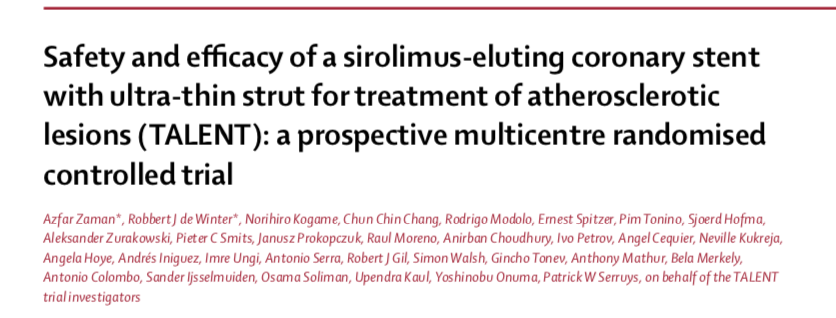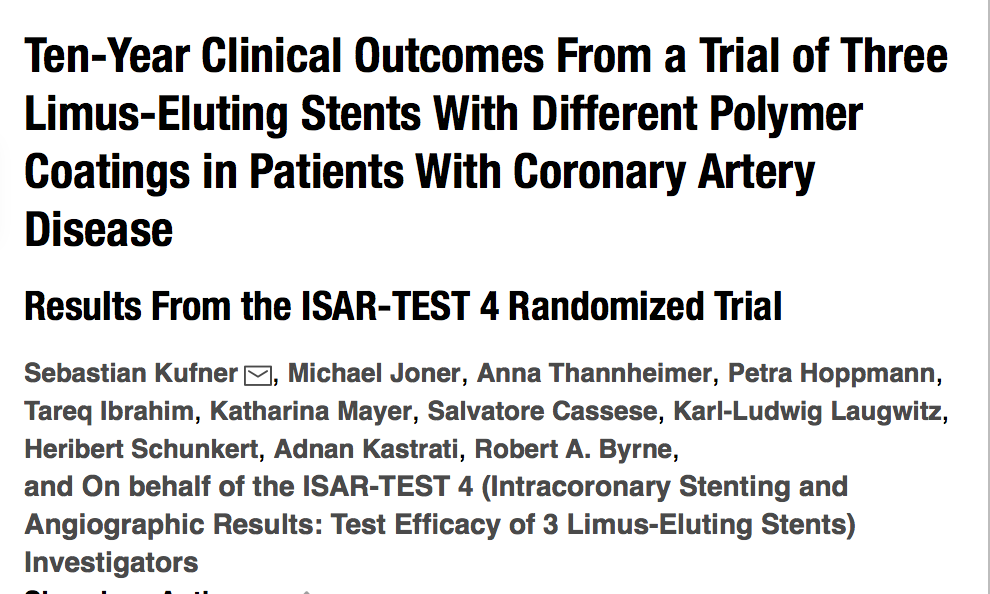
All said and done the promise of ultra thin strut stents with biodegradable polymer to cut down the incidence of stent thrombosis and neoatheroscelrosis remains to be fulfilled. Drug eluting stents (DES) have indeed reduced restenosis but have been hampered by development of late stent thrombosis and neoatherosclerosis. In order to improve clinical results ultra thin stents were developed in which strut size is a mere 60 microns. These stents are made of the allow cobalt chromium and are covered by a polymer that is only 5 microns in thickness. Moreover the polymer is biodegradable, which means that it melts away in a few months to a year, having done its job of preventing smooth muscle proliferation or restenosis. Crucially the stent left behind behaves like a bare metal stent that is incapable of inducing inflammation in the coronary artery wall. The situation that we have currently is that every ultra thin strut stent in the market carries biodegradable polymer (BP). All randomised studies done with the ultrathin strut stent have compared them with the durable polymer (DP) everolimus eluting stent ( or the Xience stent). The Xience stent has a strut thickness of 80 microns, which is also quite thin. The Xience stent and other thin strut stents with a durable polymer have provided excellent clinical outcomes compared to earlier generation drug eluting stents, but results have flattened. Second generation DP-DES have a lower risk of stent thrombosis, restenosis, myocardial infarction and death in comparison with bare metal stents. The latest ultra thin strut BP-DES also provide clinical outcomes comparable to second generation BP-DES but no randomised trial has shown superiority.
The latest trial comparing BP-DES with DP-DES ( the TALENT trial) reported similar outcomes by 12 months (Lancet 2019,393:987-97). TALENT studied 1435 patients and the primary endpoint was a composite of death, myocardial infarction or clinically indicated target vessel revascularization. At the end of one year both groups had an incidence of about 5%. Participating centres were from Europe.

The other big study comparing BP-DES with DP-DES was by the BIOFLOW V investigators (Lancet 2017;390:1843-52). More than 1330 patients were followed for one year. At the end one year the ultra thin strut BP stent outperformed DP-DES; target vessel failure was 6% vs 10%;( p=0.39). Target vessel myocardial infarction was also significantly less with the BP-DES, (5% vs. 8%, p=0.13). This was the first time that a BP-DES was found to be associated with better clinical outcomes a DP-DES (XIENCE). It should be noted that follow up was for 12 months only. The BIOFLOW V trial recruited patients from non European countries also.
A year later the BIOSCIENCE trial got published (Lancet 2018;392:737-746);. Notably, 2008 patients were followed up for 5 years.. Target lesion failure by 5 years was more or less similar in both groups of patients, 20% vs. 19%. However all cause mortality was significantly greater in the BP-DES group as compared with DP-DES ( 14% vs 10%; p=0.017). Increased deaths were found to be due to cancer; the authors considered this a chance event. There was no record of whether cancer developed prior to enrolment or during the trial.There was no difference in myocardial infarction.The investigators concluded that increased all cause mortality with the BP-DES warranted careful examination of ongoing trials. The BIOSCIENCE trial investigators claimed that to their knowledge their study was the first one to follow ups patients beyond the melting window of the biodegradable polymer.

We must go through another randomised trial that followed up 2603 patients who underwent coronary stenting for 10 years (Circulation 2019;139:325-333). The ISAR-TEST 4 Randomized trial randomised patients to a BP-SES ( number 1299), DP-DES (number 652) or DP-SES (number 652). The primary endpoint was a composite of death, myocardial infarction or target lesion revascularization. By 10 years there was no significant difference in the BP-DES and DP-DES, approximately 47% in both groups. The group with the durable polymer sirolimus eluting stent ,DP-SES, had a figure of 55%, an absolute increase of 8%. Mortality too was significantly higher in the first generation DP-SES group. Stent thrombosis was also significantly more in the first generation stent group. There were no significant differences between the BP-DES and DP-DES group. The strut thickness in the polymer biodegradable group was 87 microns with the polymer on the abluminal surface of the stent. The Xience stent has strut thickness of 81 microns. The first generation DP-DES used in the ISAR trial was the Cypher stent with thickness of 140 microns. It is obvious that at the end of 10 years the second generation BP-DES and DP-DES (everolimus eluting ) were superior to the first generation 140 microns Cypher DES. The trial enrolled a high risk group (40% patients with acute coronary syndrome, 28% diabetics, 86% with multi vessel disease).

It is clear from the ISAR trial that stent design impacts death and mtiocardial infarction as also stent thrombosis. Hence the so called “game changer” trials such as COURAGE/ BARI-2D (stable angina) or even the FREEDOM trial (CABG vs. PCI in diabetics) should not be seriously considered as these studies employed bare metal stents or the generation DES.
Currently available data makes it plausible to accept that thinner strut stent thickness are less thrombogenic than thicker strut stents, and that all polymers are not the same. The fluoropolymer on the everolimus eluting stent is certainly associated with lower inflammation and thrombogenecity. The BIOFLOW V trial is the first trial to show better clinical outcomes with an ultra thin (60 microns) biodegradable polymer (Orsiro) stent than the gold standard second generation durable polymer everolimus eluting (Xience). stent. Comparable results with an Indian manufactured BP-DES (60 microns) and DP-DES were shown by the TALENT trial, the follow up being 12 months. There is a signal that an ultra thin strut stent with a biogreafdable polymer is comparable if not better than the second generation durable polymer thin strut everolimus eluting stent. It is however unclear whether the decent clinical outcomes are due to the ultra thin nature of the stent or the fact that the polymer degrades within a few months. The answer to this question can only be answered by a study comparing an ultra thin strut drug eluting durable polymer stent (DP-DES) with an ultra thin strut drug eluting biodegradable polymer stent (BP-DES). As mentioned earlier there is no ultra thin strut durable polymer stent. Maybe a study comparing a thin strut BP-DES (85 -100 microns) with an ultra thin strut BP-DES (60 microns) would throw up interesting results, at least clarify whether stent thickness impacts clinical outcomes.